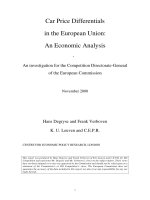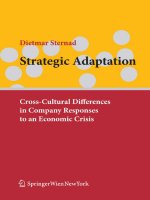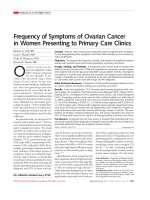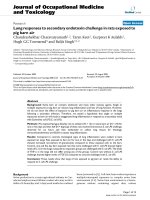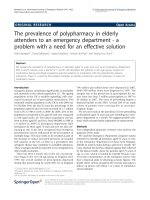Strategic Adaptation: Cross-Cultural Differences in Company Responses to an Economic Crisis pot
Bạn đang xem bản rút gọn của tài liệu. Xem và tải ngay bản đầy đủ của tài liệu tại đây (1.97 MB, 272 trang )
~
SpringerWienNewYork Dietmar Sternad
Strategic Adaptation
Cross-Cultural Differences
in Company Responses
to an Economic Crisis
SpringerWienNewYork
Dietmar Sternad
Lecturer for International Management and Program Director of the Inter-
national Business Management Master’s program at Carinthia University of
Applied Sciences in Villach, Austria.
This work is subject to copyright.
All rights are reserved, whether the whole or part of the material is concerned,
specifically those of translation, reprinting, re-use of illustrations, broadcast-
ing, reproduction by photocopying machines or similar means, and storage in
data banks.
Product Liability: The publisher can give no guarantee for all the information
contained in this book. This does also refer to information about drug dosage
and application thereof. In every individual case the respective user must
check its accuracy by consulting other pharmaceutical literature. The use of
registered names, trademarks, etc. in this publication does not imply, even in
the absence of a specific statement, that such names are exempt from the rele-
vant protective laws and regulations and therefore free for general use.
© 2011 Springer-Verlag/Wien
Printed in Germany
SpringerWienNewYork is part of
Springer Science + Business Media
springer.at
Copy editing: Mag. Julia Edtbrustner
Typesetting: Jung Crossmedia Publishing GmbH, Lahnau, Germany
Printing: Strauss GmbH, Mörlenbach, Germany
Printed on acid-free and chlorine-free bleached paper
SPIN 80018172
With 25 figures and 47 tables
CIP Data applied for
ISBN 978-3-7091-0454-5 SpringerWienNewYork
V
Contents
Figures IX
Tables XI
List of abbreviations XIII
1 Introduction: Researching strategic adaptation
in a cross-cultural context
1
1.1 Cultural influences on strategic adaptation 3
1.2 Overview of the research design 6
2 Strategic decision-making, the environment,
and national culture: An overview of key concepts
15
2.1 Strategy content 16
2.2 Strategy process 17
2.3 Four perspectives on the strategic decision-making process 18
2.4 The environment 21
2.5 Environmental change 23
2.6 The 2008– 09 financial and economic crisis as an exemplified major
environmental change 24
2.7 Adaptation as a concept in strategic management 27
2.8 National culture as an influencing factor on managerial decision-making 30
2.9 Summary of the key concepts 34
3 The strategic adaptation process: a literature review 41
3.1 From environmental determinism to strategic choice 42
3.2 Proactive versus passive adaptation 43
3.3 Adaptability: real options and dynamic capabilities perspectives 46
3.4 Cognitive perspectives of the strategic adaptation process 49
3.4.1 Attention focus 51
3.4.2 Environmental-strategy causal logic 52
Contents
VI
3.5 The sense-making process 52
Cognitive deficiencies potentially affecting the adaptation process 56
3.6 A model of the strategic adaptation process 59
3.7 Strategic issue diagnosis 65
3.7.1 Opportunities and threats 68
3.7.2 Urgency and feasibility 71
3.8 Political behaviour and conflicts in strategic decision-making processes 73
3.8.1 Political behaviour in organizations 75
3.8.2 The role of conflicts 76
3.9 Other variables with possible influence on the strategic adaptation
process 77
3.9.1 Organizational size 78
3.9.2 Industry 79
3.9.3 Slack resources 81
3.10 Summary of the strategic adaptation process 82
4 Strategic action in response to economic crises 95
4.1 Rationalizing versus protection/pre-emption strategies 101
4.2 Focus on the core business versus diversification strategies 104
4.3 Internally-directed versus externally-directed strategies 106
4.4 Summary of adaptation strategies in response to economic crises 107
4.5 Hypotheses on the link between strategic issue analysis and strategic
action in response to economic crises 109
5 Cultural differences between Austria and Slovenia 115
5.1 Performance orientation 120
5.2 Future orientation 122
5.3 Assertiveness 123
5.4 In-group collectivism 125
5.5 Uncertainty avoidance 127
5.6 Gender egalitarianism 129
5.7 Cultural dimensions without significant differences between Austria
and Slovenia 130
5.8 Summary of cultural differences between Austria and Slovenia 132
6 Cultural influences on the adaptation process 139
6.1 Hypotheses on cultural influences on strategic issue diagnosis 145
6.2 Hypotheses on cultural influences on strategic action in response to the
economic crisis 148
6.3 Hypotheses on cultural influences on political and decision behaviour
in strategic decision-making processes 151
Contents
VII
7 Qualitative study: management interviews about
strategic adaptation to the financial and economic
crisis
159
7.1 Sample and data collection of the qualitative study 159
7.2 Methodology of analysis of the qualitative study 161
7.3 Results of the qualitative study 163
7.3.1 Strategic issue diagnosis in Austrian and Slovene companies 164
Threat perception of the financial and economic crisis 164
Opportunity perception of the financial and economic crisis 164
Feasibility perception of the financial and economic crisis 168
Urgency perception of the financial and economic crisis 169
7.3.2 Political, conflict, and informal behaviour in Austrian and Slovene
companies 172
Political behaviour in strategic decision-making 172
Amount of conflict in strategic decision-making 175
Individual or group decision-making 176
Degree of informality in decision-making 178
7.3.3 Strategic action in response to the 2008– 09 financial and economic crisis
in Austrian and Slovene companies 181
Rationalization versus protection/pre-emption strategies 181
Focus on the core business versus diversification strategies 186
Other internally-oriented strategies 189
Other externally-oriented strategies 190
7.4 Summary of the findings of the qualitative study 194
8 Methodological overview of the quantitative
empirical study
199
8.1 Sample and data collection 199
8.2 Instrument design 201
Measuring strateg ic issue diagnosis constructs 202
Measuring strateg ic responses to the crisis 205
Measuring political processes and conflicts in decision-making 206
Values for dimensions of national culture 209
Control variables 209
8.3 Bias minimization steps 210
Translation bias 210
Cross-cultural equivalence 211
Retrospective reports 212
Non-response bias 212
Common method bias 212
8.4 Statistical analysis 213
Contents
VIII
9 Results of the quantitative empirical study in Austria
and Slovenia
219
9.1 Overview of respondents’ characteristics 219
9.2 Descriptive statistics 220
9.2.1 Descriptive statistics on strategic issue analysis 220
9.2.2 Descriptive statistics on crisis response strategies 221
9.2.3 Descriptive statistics on political and conflict behaviour 226
9.3 Correlations 228
9.4 Testing of hypotheses 231
9.4.1 Testing the links between strategic issue diagnosis and strategic action 231
9.4.2 Testing for cultural differences 233
Testing for cultural differences in strategic issue diagnosis 234
Testing for cultural differences in the use of strategic action 235
Testing for cultural differences in political and decision behaviour 238
9.5 Summary of the findings from the quantitative study 240
10 Discussion, conclusions, and outlook 245
10.1 Discussion of findings on the strategic adaptation process 245
10.2 Discussion of findings on cultural, industry, and size differences
in strategic adaptation to an economic crisis 247
10.3 Limitations of the study 248
10.4 Conclusions 250
10.5 Implications for practice 252
10.6 Opportunities for further research 253
IX
Figures
1.1 Research design overview 9
2.1 The four perspectives on the strategic decision-making process 19
2.2 Aspects of strategic adaptation to the 2008– 09 financial crisis within the
scope of this study 27
2.3 Typology of adaptation 29
2.4 The ‘onion model’ of culture 32
2.5 An integrative model of influences on top managers’ perceptions 33
3.1 Meyer’s model of organizational adaptation to environmental jolts 60
3.2 The strategic adaptation process 63
3.3 The influence of national culture on strategic decision-making, political
processes, and strategic action in strategic adaptation processes 65
3.4 The opportunity/threat issue interpretation space 71
3.5 Political influences on the strategic adaptation process 75
4.1 Dichotomies in strategic responses to sudden economic downturn 100
4.2 Strategic growth and divestment responses 105
4.3 Internally-directed and externally-directed strategic responses to sudden
economic downturn 107
4.4 Hypotheses on the relationship between strategic issue diagnosis and
strategic action in response to economic crises 111
6.1 Cultural influence on strategic decisions 140
6.2 Hypotheses on cultural influences on strategic issue diagnosis 148
6.3 Hypotheses on cultural influences on strategic responses to the economic
crisis 151
6.4 Hypotheses on cultural influences on political and decision behaviour in
strategic decision-making processes 154
7.1 Major environmental change as a catalyzer for enabling strategic change 168
9.1 Results of strategic issue perceptions of the 2008– 09 financial and economic
crisis 220
9.2 Strategic responses to the 2008–09 financial and economic crisis
(categories) 222
Figures
X
9.3 Strategic action on the diversification versus focus on the core business
dimension 224
9.4 Strategic action on the internally- versus externally-directed dimension 225
9.5 Overview of decision-making variables results 227
XI
Tables
2.1 Strategy levels overview 16
4.1 Selected research results on strategic responses to economic cr ises and
recession 95
4.2 Rationalizing versus protection/pre-emption responses to sudden economic
downturn 103
5.1 GLOBE performance orientation values for Austria and Slovenia 121
5.2 GLOBE future orientation values for Austria and Slovenia 123
5.3 GLOBE assertiveness values for Austria and Slovenia 125
5.4 GLOBE in-group collectivism values for Austria and Slovenia 127
5.5 GLOBE uncertainty avoidance values for Austria and Slovenia 129
5.6 GLOBE gender egalitarianism values for Austria and Slovenia 130
5.7 Differences in cultural dimensions between Austria and Slovenia in the
GLOBE study 130
5.8 GLOBE societal institutional collectivism values for Austria and Slovenia 131
5.9 GLOBE power distance values for Austria and Slovenia 131
5.10 GLOBE humane orientation values for Austria and Slovenia 132
5.11 Summary of major cultural differences between Austria and Slovenia in the
GLOBE study 132
6.1 Overview of empirical studies exploring cross-cultural differences in the
strategic decision process 142
7.1 Overview of the companies and interviewees of the qualitative study 160
7.2 Overview of categories and parameter values for the qualitative content
analysis 162
7.3 Threat and opportunity perception of the financial and economic crisis in
Austrian and Slovene companies 165
7.4 Feasibility and urgency perception of the financial and economic crisis in
Austrian and Slovene companies 170
7.5 Extent of political behavior and conflict in strategic adaptation to the crisis
in Austrian and Slovene companies 173
7.6 Ambiguous statements about individual and group decision-making 177
Tables
XII
7.7 Decision-making behavior and informality in strategic adaptation to the
crisis in Austrian and Slovene companies 179
7.8 Frequency of occurrence of specific rationalization strategies 182
7.9 Rationalization and protection/pre-emption strategies in Austrian and
Slovene companies 183
7.10 Frequency of occurrence of specific protection/pre-emption strategies 185
7.11 Frequency of focus on the core business versus diversification strategies 186
7.12 Focus on the core business versus diversification strategies in Austrian and
Slovene companies 187
7.13 Frequency of occurrence of other internally-oriented strategies 190
7.14 Frequency of occurrence of other externally-oriented strategies 191
7.15 Other internally and externally-directed strategies in response to the crisis
in Austrian and Slovene companies 192
8.1 Change in industry turnover index (nominal) from 2008 to 2009 199
8.2 Survey response rates 201
8.3 Overview of items of the opportunity and threat constructs 202
8.4 Overview of items of the feasibility and urgency constructs 204
8.5 Overview of conflict items 207
9.1 Respondents’ and their firms’ demographic characteristics 219
9.2 Statistics on strategic issue diagnosis of the 2008– 09 financial and economic
crisis in Austria and Slovenia 221
9.3 Statistics on strategic responses to the 2008–09 financial and economic
crisis (categories) 223
9.4 Rationalization versus investment in response to the crisis 226
9.5 Group decision-making, conflict, self-interest, and informality in strategic
decision-making in response to the economic crisis 228
9.6 Correlation of main variables (Spearman’s rho) 229
9.7 Hierarchical regression results: influence of strategic issue diagnosis on
strategic action 232
9.8 Statistical tests of country differences 233
9.9 Hierarchical regression results: influence of country differences on crisis
interpretations 235
9.10 Hierarchical regression results: influence of country differences strategic
action 236
9.11 Hierarchical regression results: influence of country differences on decision
behaviour 239
9.12 Summary of hy potheses testing results 241
XIII
List of abbreviations
AUT Austria
CEC Current economic conditions
CEO Chief Executive Officer
DCF Discounted cash flow
EVS European Values Survey
GDP Gross domestic product
GLOBE Global Leadership and Organizational Behaviour Effectiveness
Program
HR Human resources
L Large-scale corporation (in the qualitative study, chapter 7)
MBA Master of Business Administration
N/A Not applicable
No. Number
NPV Net present value
PESTEL Political, economic, technological, environmental, and legal
factors
PIMS Profit Impact on Market Strategy
POPS Perception of Politics Scale
PR Public relations
RBV Resource-based view
R&D Research and development
S Small and medium-sized enterprise (in the qualitative study,
chapter 7)
S.d. Standard deviation
SLO Slovenia
SME Small and medium-sized enterprise
Std. error Standard error
UK United Kingdom
U.S. United States
VIF Variance inflation factor

